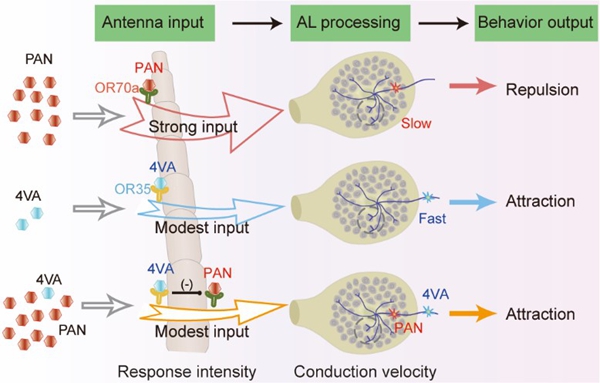In the natural world, animals rely on perceiving a range of signals to survive-and for insects, olfactory cues are particularly critical. These scents guide them to vital resources like mates, food, and egg-laying sites, yet they also include a mix of attractants and repellents, creating a complex sensory landscape to navigate.
For the migratory locust (Locusta migratoria), this complexity becomes even more pronounced at high population densities. When numbers surge, the insects form massive swarms while releasing two key chemical signals: the aggregation pheromone 4-vinylanisole (4VA) and the aposematic compound phenylacetonitrile (PAN). 4VA draws locusts together to form swarms, while PAN deters fellow locusts to prevent cannibalism and repels potential predators. This raises a critical question: How do locusts reconcile the conflicting behaviors of aggregation and repulsion when they detect both compounds at the same time?
To solve this behavioral puzzle, a team from the Institute of Zoology of the Chinese Academy of Sciences (CAS), led by CAS member Prof. KANG Le, has conducted research and discovered that migratory locusts achieve a delicate balance between swarm formation, predator defense, and cannibalism avoidance through precise neural modulation of these two opposing olfactory signals.
Their findings were published in Proceedings of the National Academy of Sciences (PNAS).
The researchers analyzed three core aspects: the release dynamics of 4VA and PAN, their distinct effects on locust behavior, and the neural mechanisms that govern how the insects perceive these signals.
Their experiments showed striking differences in when and under what conditions the two compounds are released. When locusts were subjected to the same duration of crowding, 4VA was emitted at significantly lower population densities-just four to five locusts-compared to PAN, which required a denser group of 16 to 17 solitary locusts. Even at equivalent population densities, 4VA release began earlier: it was detected after 24 hours of crowding, while PAN emission started only after 48 hours. Over time, however, PAN gradually became the dominant component as the aggregation process progressed.
Despite PAN eventually reaching higher emission levels than 4VA, the locusts consistently showed a preference for the blend of the two compounds, regardless of changes in their relative proportions or overall concentrations. A key observation emerged: adding increasing amounts of 4VA to PAN could counteract PAN's repellent effects. Notably, the reverse was not true-adding more PAN to 4VA did not override 4VA's attractant properties.
To understand why 4VA dominates the locusts' behavioral response to the mixture, the team measured electrophysiological activity in the insects' antennae-the primary organ for olfactory detection. They found that neurons in the antenna that respond to 4VA actively suppress the activity of neurons sensitive to PAN.
Further investigation into the locusts' antennal lobe-the brain region that processes olfactory information-revealed another crucial detail: the spatio-temporal response patterns of projection neurons (PNs) to the 4VA-PAN blend were far more similar to the patterns triggered by 4VA alone than by PAN alone. The researchers then identified the root cause of this dominance: the conduction velocity of these projection neurons. Unlike other neural properties, the speed at which these neurons transmit signals drives the locusts' overall attractive response to the mixture.
This study offers new insights into how animals make behavioral decisions when faced with conflicting sensory inputs.

The synergistic interactions between 4VA and PAN across multiple levels facilitate locust attraction and aggregation. (Image by Prof. KANG Le' Lab)






